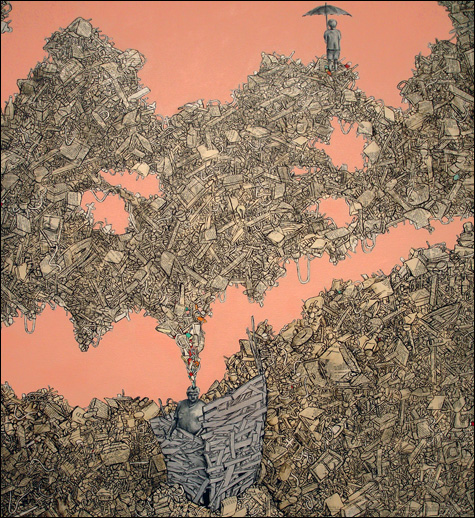Yeshe Parks explores the junkyard at Whitney Art Works
By IAN PAIGE | August 20, 2008

TAKING SHELTER: "Outpost," by Yeshe Parks. |
| "New Works" by Yeshe Parks and Sean Foley | through August 30 | at Whitney Art Works, 492 Congress St, Portland | 207.774.7011 |
Modern stylings inspired by graffiti and the hyperreal imaging sensibilities of digital design pose a challenge for young artists seeking to integrate their visual vocabulary into a fine art context. In the back room gallery of Whitney Art Works, young Maine-based artist Yeshe Parks reveals to us this trajectory of translation with a collection of recent work. The breadth of exploration is tempered by a sure hand that provides a continuity of quality on an artistic odyssey to find not only form, but also a deeper meaning in the process.Parks’s search is given context by its origins. Although only a year old, the acrylic piece entitled “Two By Two” is considered an early work for this exhibit's purposes, and it doesn’t quite work. Comic-book crowds of people file behind a bizarre rabbit-like creature enduring swirling shapes pouring from its upright ears. The unity of the whole is lost in the panoply of forms; the composition seems to be determined more in the style of starting at one point in your science class spiral notebook and doodling until you fill the page.
Parks finds a voice for his style in “Uranographer I” and “II,” which solve the problem of unity with a decisive use of negative space to balance his fascination with a junkyard jumble of objects. In both paintings, rendered in oil and containing elements of collage, a small figure is poised in the bottom left corner in relation to a looming mass of light bulbs, piping, and iron beams peppered with brightly colored pills and matchsticks that contrast with the gloomy dark brown lines and shadows. Parks makes the base mass of torn dictionary scraps recede with his line drawing unless you consciously tend to it. Here is an introduction to a constant in Parks’s work. The micro and macro are in constant interplay, the mass is as relevant as the detail, and the viewer delights in stepping back or coming in for a closer look.
In “Outpost,” a coral-colored background bisects two now-familiar knotted masses. In addition to the junk piles, there are two figures. One is a middle-aged man constructing a slapdash shed of scrap wood as though to protect himself from the upper-level junk pile rapidly funneling into his head. Perched atop this upper-tier swarm is a small child looking out into the blank background, his back turned and holding an umbrella. The human relation to objecthood and inherited or abandoned perceptions is called into question. What do we receive and what do we create with these perceptions? Parks makes it clear that it’s very difficult to do anything other than build shelter in the face of this avalanche of culture.
Most of Parks's drawings are extremely intimate, drawn lightly in pencil on achingly old paper or pasted to old book covers for a measure of antiquity. One drawing that stands out from this series is “Our Memories and Experiences Pull Us Through to the Present.” Elegant rather than intimate, light pencil marks form a giant gestural body surrounded by a swathe of the white paper. The figure itself is under construction, composed of iron bars, a skeleton being “developed” by houses and cars — outposts of civilization. The self is seen as a work in progress, measured in the roads it has traveled.
 Topics
Topics:
Museum And Gallery
, Sean Foley, Yeshe Parks